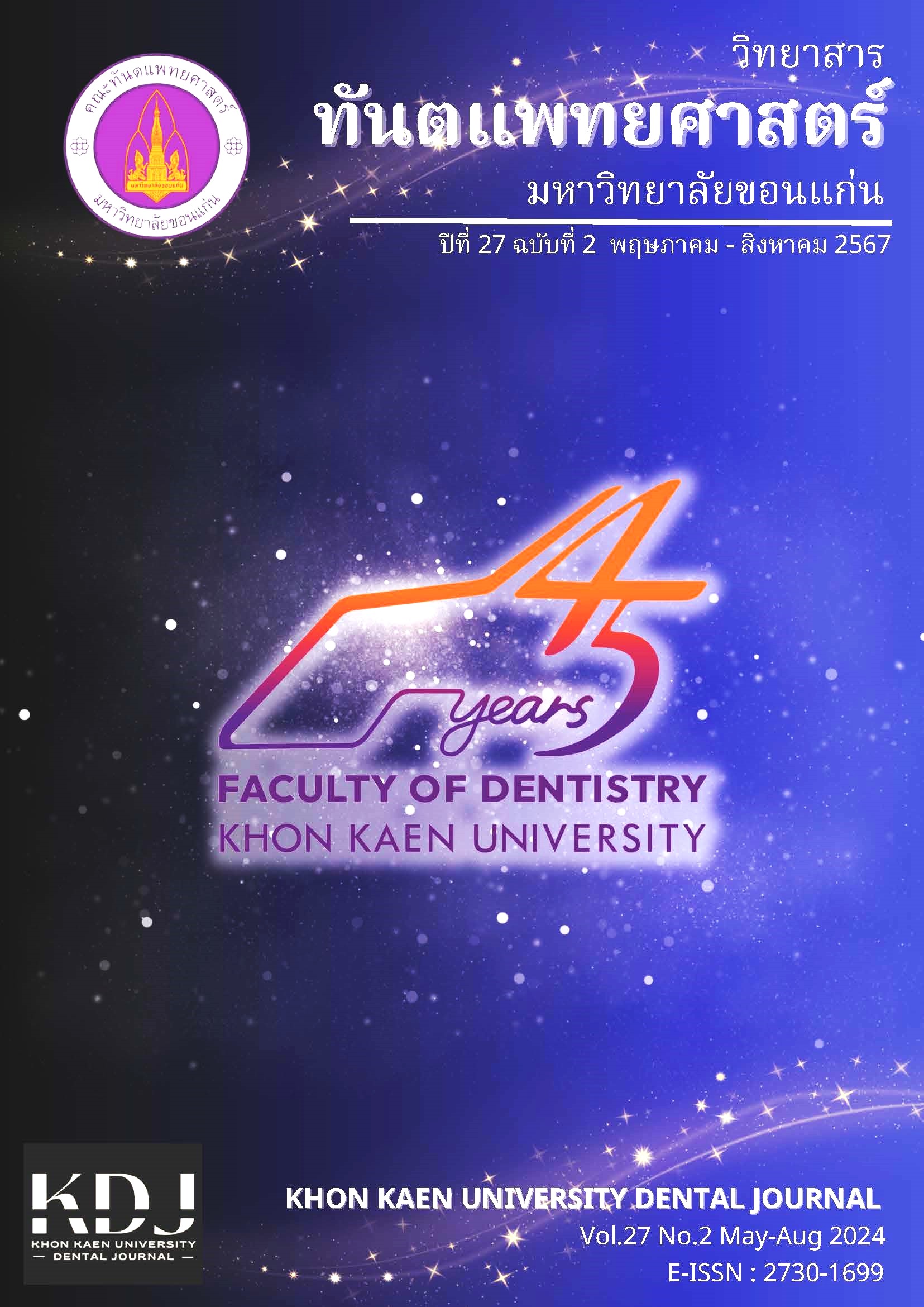Guidelines for Creating the Complete Denture Data Bank: Two Case Studies
Main Article Content
Abstract
The data collected via digital dentistry systems on patients wearing complete dentures without any problems for a certain period can be utilized for creating subsequent sets of dentures, if needed in the future. Dentures are scanned, and bite registration details are digitally recorded and stored as a digital file in the “denture data bank”. The time required for constructing a new set of dentures could be reduced, especially in the elderly population, which is growing rapidly as we move towards an aging society. Elderly individuals facing, health issues may have limitations in attending multiple dental appointments or may be unable to cooperate with treatment due to conditions such as Alzheimer or dementia. The denture data bank could minimize the number of appointments required and will be beneficial for the patient in the future.
Article Details

This work is licensed under a Creative Commons Attribution-NonCommercial-NoDerivatives 4.0 International License.
บทความ ข้อมูล เนื้อหา รูปภาพ ฯลฯ ที่ได้รับการลงตีพิมพ์ในวิทยาสารทันตแพทยศาสตร์ มหาวิทยาลัยขอนแก่นถือเป็นลิขสิทธิ์เฉพาะของคณะทันตแพทยศาสตร์ มหาวิทยาลัยขอนแก่น หากบุคคลหรือหน่วยงานใดต้องการนำทั้งหมดหรือส่วนหนึ่งส่วนใดไปเผยแพร่ต่อหรือเพื่อกระทำการใด ๆ จะต้องได้รับอนุญาตเป็นลายลักษณ์อักษร จากคณะทันตแพทยศาสตร์ มหาวิทยาลัยขอนแก่นก่อนเท่านั้น
References
Kouveliotis G, Tasopoulos T, Karoussis I, Rfa Silva N, Zoidis P. Complete denture digital workflow: Combining basic principles with a CAD-CAM approach. J Prosthet Dent 2021;127(4):550-55
Lo Russo L, Salamini A, Troiano G, Guida L. Digital denture: A protocol based on intraoral scans. J Prosthet Dent 2021;125(4):597-602.
Infante L, Yilmaz B, McGlumphy E, Finger I. Fabricating complete dentures with CAD/CAM technology. J Prosthet Dent 2014;111(5):351-55
Kattadiyil MT, AlHelal A. An update on computer-engineered complete dentures: A systematic review on clinical outcomes. J Prosthet Dent 2017;117(4):478-85.
Kattadiyil MT, Jekki R, Goodacre CJ, Baba NZ. Comparison of treatment outcomes in digital and conventional complete removable dental prosthesis fabrications in a predoctoral setting. J Prosthet Dent 2015;114(6):818-25.
Kattadiyil MT, AlHelal A, Goodacre BJ. Clinical complications and quality assessments with computer-engineered complete dentures: a systematic review. J Prosthet Dent 2017;117(6):721-28.
Wimmer T, Gallus K, Eichberger M, Stawarczyk B. Complete denture fabrication supported by CAD/CAM. J Prosthet Dent 2016;115(5):541-6.
Saponaro PC, Yilmaz B, Heshmati RH, McGlumphy EA. Clinical performance of CAD-CAM fabricated complete dentures: A cross-sectional study. J Prosthet Dent 2016;116(3):431-5.
Lo Russo L, Caradonna G, Troiano G, Salamini A, Guida L, Ciavarella D. Three-dimensional differences between intraoral scans and conventional impressions of edentulous jaws: A clinical study. J Prosthet Dent 2020;123(2):264-68.
Lo Russo L, Salamini A. Removable complete digital dentures: A workflow that integrates open technologies. J Prosthet Dent 2018;119(5):727-32.
Lo Russo L, Salamini A. Single-arch digital removable complete denture: a workflow that starts from the intraoral scan. J Prosthet Dent 2018;120(1):20-4.
Lo Russo L, Ciavarella D, Salamini A, Guida L. Alignment of intraoral scans and registration of maxillo-mandibular relationships for the edentulous maxillary arch. J Prosthet Dent 2019;121(5):737-40.
Srinivasan M, Gjengedal H, Cattani-Lorente M, Moussa M, Durual S, Schimmel M, et al. CAD/CAM milled complete removable dental prostheses: An in vitro evaluation of biocompatibility, mechanical properties, and surface roughness. Dent Mater J 2018;37(4):526-33.
Bidra AS. The 2-visit CAD-CAM implant retained overdenture: A clinical report. J Oral Implantol 2014;40(6):722-8.
AlHelal A, AlRumaih HS, Kattadiyil MT, Baba NZ, Goodacre CJ. Comparison of retention between maxillary milled and conventional denture bases: A clinical study. J Prosthet Dent 2017;117(2):233-8.
Afify A, Haney S. Enhancing fracture and wear resistance of dentures/overdentures utilizing digital technology: a case series report. J Prosthodont. 2016; 25(6):489–94.


